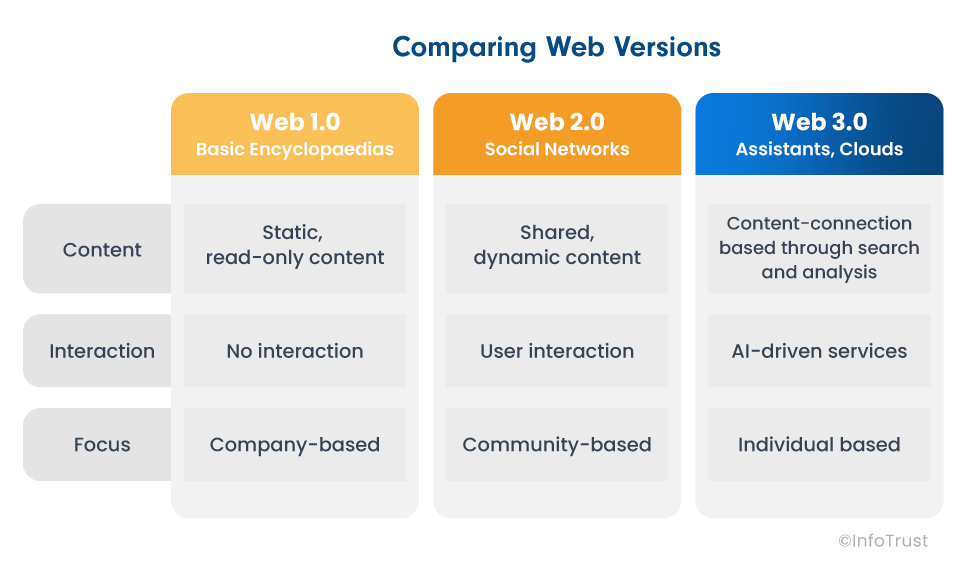Amidst the crypto scams, media hype, and legitimate technical breakthroughs lies something the internet is calling web3. A fairly new term—meant to signify this is the third version of the web—has been a buzzword around the internet, but what does it mean?
I’ll lead with a quote from Molly White’s Is Web3 Bullshit?:
“The thing about a term like ‘web3’ is you don’t necessarily know what it is until it’s happened. You don’t know what that fundamental shift is going to be that brings about a sea change in the web that deserves the name ‘web3’.”
I like to use this quote when approaching web3 topics because it expresses uncertainty in an area where everyone seems so certain. It’s important to practice some skepticism, in everything really, but specifically web3 as there are many who have a vested interest in you believing their version of web3 is true. My goal in this article is to clarify a few things:
- What things can be possibly considered web3
- What are web3 platforms and what are web3 concepts
- How can you talk about web3 intelligently
Since the very definition of web3 is a little all over the place, let’s do a quick history lesson.
A Look Back
A long time ago, Tim Berners-Lee started the world wide web, and this would be the birth of Web 1.0. Web 1.0 was read-only, which meant you visit a website, but you do not interact with it (basically it was billboards all over the internet that you would visit virtually).
This evolved into Web 2.0 where interaction was possible. Now, not only can you visit the information, but you can interact with it. Take a pizza parlor for example. In Web 1.0, you could see the menu; but in Web 2.0, you could order a pizza by interacting with the site.
These are community-driven terms, but for the most part Web 1.0 and Web 2.0 are widely accepted.
Now things get fuzzy. Tim Berners-Lee wanted the next evolution of the web to be the Semantic Web, which he called Web 3.0. This version of the web would be a better, more uniform way to store the information we use on the internet to make it more machine- and human-readable. While this version of Web 3.0 was crawling forward, an entirely different movement began.
This new moment was centered around course correcting from the oligarchy of big tech. Ideas of decentralization, distributed ownership, monetization through participation in infrastructure, and more were tenets to be used in the creation of a new style of internet infrastructure. An early example of this is blockchain technology, notably used in the Bitcoin network. With these core tenets and some breakthroughs in cryptography, a new wave of decentralized, community-owned, monetarily-incentivized platforms began to hit the internet under the classification of web3.
However, this wave led to a lot of uncertainty and commandeering of the cause. Not every system that claimed web3 held these tenets, and many tried to use the boom of a new technology to dupe and carve out a fortune of their own.

What Some Claim web3 to Be
In an effort to put some rails on the explanation of what web3 could be, lets outline a few things people have described web3 as:
- Blockchain: A cryptographically-linked list that operates as an immutable ledger
- Trustless Internet: A new internet concept using technology like blockchain to create environments where the concept of trust is not needed (it’s impossible to dupe the system)
- Decentralized Ownership: An internet where big tech no longer owns the system, but instead the users own the very internet itself, as well as underlying applications
- Digital Experiences: Augmented Reality (real life with a digital overlay) and Virtual Reality (a simulation of real life through a lens) expand the ways we interface with the physical world
- Monetary Incentive: An internet where taking part in the infrastructure pays you for taking part in the infrastructure. Rather than a few companies being the “hosting” infrastructure for sites and apps you visit, instead individual users of the internet lend part of their computers’ memory and processing to be part of hosting all the sites on the internet. This puts power in the users’ hands (paying them to do so), and keeps the internet from being a monopoly.
- Artificial Intelligence: By using logical engines, we improve the tedious tasks of the internet where machines can begin to make better decisions for us leading to a more productive internet.
- Personalization: A web where the internet knows exactly what you want and what to suggest for you to eat, listen to, what movie to see, etc. This is polarizing as many view this as paradise, and others view it as massively invasive.
- Digital Asset Ownership (including NFTs): An internet where the capitalist notions of physical ownership are transferred to the digital space. Art, property, music, games, etc. are owned, verified, and traded for their uniqueness.
- Semantic Web: A web of interconnected knowledge graphs that serves as a new backend for our internet. These connected data structures would serve to link information together in a more intelligent way to increase the ability of humans and machines to search data.
Now, there are more classifications, but these are the more common ones so for simplicity and clarity sake this is the list. Referring back to the goals of this article, the above is a list of what web3 “could” be, but now we need to classify what are the concepts and what are the platforms, and hopefully in doing that speak a bit more clearly around web3.
How Everything Relates to Blockchain
Blockchain isn’t a platform, but instead a technique—it’s a conceptual way of executing against a certain problem. Specifically, blockchain is a list of items that are chained together with code using cryptography that make computers better at certain tasks. Blockchain makes it a trustless ledger that can not be changed, and the entire ledger can be verified for accuracy really quickly. Not only are most blockchain networks trustless, but they are also distributed which means everyone has a copy of the chain (ledger) and continues to verify every ledger translation on the network.
If our ledger is a receipt of money transactions whenever a transaction is made, everyone has to record it on their ledger. In order to prove that a transaction didn’t take place, you would have to alter the ledger on everyone else’s computer, which is nearly impossible. This is what makes the system trustless. If a bank gets hacked, they can delete your balance; but if your balance is on 50,000,000 computers (distributed ledger) then someone would have to hack all 50,000,000 to incorrectly remove your balance. It’s trustless—not because it can’t be trusted—but because we don’t even need the word trust in a system like this. It’s fundamentally undupable.
Also, we are talking about another key piece here without saying it, which is ownership. Not only does everyone own their own copy of the ledger on their computer, but by taking part in the system, they own part of the infrastructure itself. Without them, being one of the 50,000,000 computers running the platform the system itself would be a little less strong. It’s the community ownership of the platforms that boosts the value of the platform. This ownership is not without reward either. People who take part in the system do so for monetary incentives, which often take the form of tokens. Tokens are a type of currency used often in blockchain networks that represent work done on verifying or taking part in the chain. The coin’s value is backed by the value of the platform itself. So not only does distributed ownership improve trustlessness and platform stability, but it rewards users with monetary value for taking part in the system itself.
While some may explain it differently, the previous few paragraphs describing blockchain is not a very controversial topic. Most of the community can agree that is what is happening with this specific technology. The thing that is hard to define is what is web3—and its relationship to blockchain. On this subject, the jury is still out.
My personal definition of web3 is not limited to any specific technology or platform. Instead I define web3 as a set of core tenets that the next generation of internet could be built upon. These tenets include decentralization of infrastructure, community ownership, monetary incentives, and trustlessness. Upon these pillars many new technologies can be built, and they are not limited to just blockchain. My purpose for sharing this definition is to achieve my third goal for this article, and make conversations around web3 a little more structured and clear.



